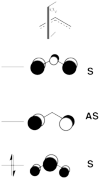VBTutorial1
Révision datée du 25 mai 2012 à 08:49 par Fmying (discussion | contributions) (→Exercise 1 (paper exercise) : The lone pairs of H2O)
How to modify this page :
- first : log in (top right of this page) ;
- click on [edit] (far right) to edit a section of the page ;
- write your text directly in the wiki page, and click on the "Save page" button (bottom left) to save your modifications
See also this page for an introduction to the basics of the wiki syntax
To the Tutors
Sason remarks and prospective 2 hours talk +
Philippe's remark on the initially proposed tutorial. are included in bold.
Qualitative
- Exercices from The Book ... >PCH< (30')
Computational
- FH (2 structures), F2 : VBSCF, different correlation wave functions (BOVB, VBCI,...), computation of weights and "charge-shift" character, also compare to CASSCF wave functions in the same basis set (probably to provide in order to avoid to spend time there).
- R-X bond dissociation to R. .X and R(+) (-)X for stable ionic dissociation ... via solvent effects? (is that possible with xiamen ?)
Exercices
Exercise 1 (paper exercise) : The lone pairs of H2O
This exercise aims at comparing two descriptions of the lone pairs of H2O : (i) the MO description in terms of non-equivalent canonical MOs and (ii) the « rabbit-ear » VB description in terms of two equivalent hybrid orbitals.

- Focusing on the lone pairs only, write the four-electron single-determinants MO and VB.
- Expand VB into elementary determinants containing only n and p orbitals, eliminate determinants having two identical spinorbitals, and show the equivalence between VB and MO.
- We now remove one electron from H2O. Write the two possible VB structures 1 and 2 in the VB framework.
- The two ionized states are the symmetry-adapted combinations and . From the sign of the hamiltonian matrix element , give the energy ordering of the two ionized states.
- By expanding the two ionized states into elementary determinants (dropping the normalization constants), show that they are equivalent, respectively, to the MO configurations and .
Appendix
Hamiltonian matrix element between determinants differing by one spin-orbital :
Exercice 2 (title)
Subject
Here is a image example
